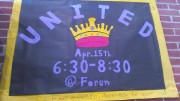Qadir Temori is an archeologist in an ongoing battle. His project, Mes Aynak, is not particularly threatened by decay, with the 5000-year-old site being in remarkably good shape. His prime enemy is man made—The Metallurgical Corporation of China (MCC). The clock ticks as Temori rushes to excavate this ancient site before it is turned into an open-pit copper mine.
It was this issue that members of the McDaniel community reflected on in a screening of “Saving Mes Aynak” (2014), a documentary by Brent E. Huffman detailing the struggle of Temori and all of those involved in the conflict of cultural heritage versus the profits of mining.
The screening was sponsored by Global Initiatives, and featured a post-viewing discussion by Dr. Gretchen McKay, Professor of Art History.
Intriguingly, it was copper that also drew bronze age Buddhist settlers to the site during its long history as a stop on the Silk Road—excavations have unearthed a myriad of copper objects and ancient smelters. Remarkably, even a number of intact wooden Buddhas are being unearthed at Mes Aynak.
Undoubtedly, the site holds a great deal of cultural and historical importance, but Afghanistan’s economic needs have made this difficult to prioritize. As of 2015, the nation’s GDP per capita sat at only $590. Thus, despite Afghan reluctance of and inexperience with foreign private contracts, MCC won the rights to mine the site in 2007.
Accusations of corruption then arose. “Saving Mes Aynak” features the Afghan Minister of Mines Nasir Durrani, who highlights strictly the economic benefits of the project—namely a money flow and job supply greatly needed in Afghanistan. Nonetheless, his predecessor was forced to step down amid accusations of accepting a $30 billion bribe from the Chinese company.
Meanwhile, those excavating Mes Aynak face heavy underfunding. In one instance, the documentary shows workers remarking that they hadn’t seen any payment in three months. Additionally, despite promises for a computer to map the site, Temori eventually expresses outrage at the continued lack of any such device.
Wealthier Western archeologists funded from foreign sources or the Afghan Ministry of Mines have been assisting in Mes Aynak. Those hired by the Ministry of Mines to hasten the operation are repeatedly confronted by Temori after destructing parts of the site in their rush to find relics. Towards the end of the documentary, foreign archeologists left due to safety concerns by their embassies.
The projected impacts of MCC’s mining project extend beyond the destruction of Mes Aynak. The documentary highlights that the water supply to 174 villages would be harmed and that six villages will be demolished completely—leaving residents nowhere to go from their razed ancestral homes.
MCC, as a whole, has been blamed for environmental destruction even in its native China. The corporation itself claims that it tries to be nice to locals, citing that its outsourcing already provides jobs to Afghans.
The “antagonists” confronted by Temori and his colleagues stretch beyond MCC and the Afghan government—there are also threats from the Taliban. “Saving Mes Aynak” features the destruction of the the Buddhas of Bamiyan, relics back to Afghanistan’s Buddhist heritage. Rejecting history before the rise of Islam, these ancient statues were blown up.
As a Buddhist site, Mes Aynak faces similar disregard. Workers confront threats from the Taliban, with a worker even bringing up a time he struck a landmine, severely damaging his eyesight. The issue of security in Afghanistan was heightened after the U.S. withdrawal from the nation—Temori and others believe that Afghan forces are not yet prepared to maintain security.
Temori’s family—his three young children and father as seen in the documentary—fear for his safety until he returns to Kabul every day. “Saving Mes Aynak” puts special emphasis on the life of Temori, showing his religious activities and recreational times with family; his life beyond Mes Aynak.
Temori feels that culture is eternal, whereas any copper mine (and Chinese money) would be temporary, eventually leaving Afghanistan after destroying Mes Aynak.
Miraculously, the site is still intact due to international outcries regarding MCC’s intentions and falling copper prices. Ultimately, however, this example shows the importance and perpetuity of culture, which can greatly outlive sporadic economic developments.




